Transnational Learning
Using a number of exemplary biographies, conversations, films, and archival materials, this text pursues the question of how transnational learning looked or rather might have looked at the German Film and Television Academy (DFFB). Concentrating primarily on the students who came and continue to come to the DFFB from other countries is by no means unproblematic. It takes into account a heterogenous group that has remained rather invisible in writing on the DFFB’s history. My research began back in the early 1990s when Germany’s persistent denial of being a country of immigration, a citizenship law that was still based on the principle of ancestry (jus sanguinis) and did not recognize the principle of birthplace (jus solis), a repressive change in right of asylum and the racist pogroms of the post-reunification period made it urgently necessary for me to consider films that had been produced in Germany by male and, above all, female1 migrants or second generation migrants. This is how I came across films by several female DFFB students—Sema Poyraz, Yingli Ma, Wanjiru Kinyanjui, Tsitsi Dangarembga—that focused on topics of transnational relations and also took a subjective, precise, and critical look at social relations here in Germany. The practical, everyday effects of structural conditions have to be included as well: the endless walks, for example, to the Ausländerbehörde (foreigners office) to renew a residence permit.2 Still aware of the ambivalence of my undertaking, I am continuing my research on this topic here. Central to this non-exhaustive research are applications, student records, and student films, especially from the DFFB’s early years, which are held at the Deutsche Kinemathek in Berlin.
A Cosmopolitan Program
There was a certain cosmopolitanism to the program of the newly founded film academy in West Berlin. In a 1963 study, Heinz Rathsack, who would later become the DFFB’s founding director, compared four film schools in Rome, Paris, Madrid and Łódź, placing positive emphasis on the proportion of foreign students. For IDHEC in Paris, he names the figure of 681 alumni since the school was founded in 1944, out of which 307 had come to France from other countries; up until 1960, students from 58 countries had attended the film school. “This figure already conveys an impression of the degree to which this institute has an effect beyond France. Furthermore, the list of former students shows that after the USA and Brazil, African and Asian countries supply IDHEC with the most foreign students.”3
West Berlin’s special role in the Cold War called for a prestigious program to compete with the “Eastern Block,” where film education was oriented by Moscow’s VGIK (All-Russian State Institute of Cinematography), which had been founded in 1919. Its students included Sarah Maldoror from Guadeloupe, Ousmane Sembène from Senegal, Souleimane Cissé from Mali and, later, Abderahmane Sissako from Mauritania as well as several filmmakers from the GDR such as Iris Gusner or Konrad Wolf. During the GDR era, there were many students at the German Academy of Film Art (HFF, today the Konrad Wolf Film University of Babelsberg, founded in 1954 in Potsdam-Babelsberg) from Vietnam, Chile, Palestine and Bulgaria as well as Arab and African countries—(brother) countries struggling to free themselves from colonialism. Thus, in Babelsberg, Mohand Ali Yahia shot his 1962 thesis film Die Frage (The Question) about torture in the Algerian War, interviewing Henri Alleg, author of the book La question,4 who had been persecuted in France following its publication.
The “Third World” at the Academy’s Doorstep?
There were 800 applications for the DFFB’s first year. With the push to become politicized following the violent death of Benno Ohnesorg on June 2, 1967, hope in a cinema that did not divide aesthetic and political effects became ever more urgent. Questions were also posed about class relations within the educational system. In a paper on the “1970 Entrance Exam and Beyond,”5 Klaus Wildenhahn, who had taught at the DFFB since 1968,6 sparked a debate about the goals of the upcoming entrance exam, demanding “applicants be accepted whose diversity corresponds to the occupational and social branches at the academy’s doorstep. Social classes must be considered that are interested in solutions to and demonstrations of political problems out of self-interest. Films about wage earners, employees, repression, etc. should no longer be made without the collaboration of authors who have had relevant experiences.” Wildenhahn broaches the issue here of the problematic representational function of many films that stood in conflict with the self-articulation demanded by political subjects.7 It was about “being clear about the key fact that places in the academy are distributed according to students’ backgrounds and how to cater to these.” “Privileged educational classes,” should not be ignored entirely, but students from that part of the middle class should be admitted “that is subjected to the particular pointlessness of mobile and reified employee existence as well as those who have not had the privilege of a good education. Starting point: industrial unions.” And as his final point, he proposes: “Third World.”8 “Proposal: to offer three free spots to the Argentinian circle around [Fernando E.] Solanas. Exemption from pre-selection and selection.”
DFFB student Johannes Beringer recalls a screening of Solanas’ paradigmatic film La hora de los hornos (The Hour of the Furnaces, AR/CU, 1968) at the Pesaro Film Festival: “After the screening … and fueled above all by the Ché Guevara sequence in the final section (the photo of the deceased Ché had just made its way through the press), the ‘revolutionary’ mood caused quite a stir: I can still remember how fired up and ready for action we were as we came out of the jam-packed theater … .”9
The “free spots” for students from Fernando Solanas’ circle never materialized, however. And only much later did (a handful) of the offspring of the first generation of migrant workers come to the film academy. In the DFFB’s early years, some things ring of tokenism, or empty talk. Nevertheless, in the academy’s history, enormous impulses emanated from the “foreign” students, which (as is the case for all students) did not always lead to “student film projects” that could be distributed or canonized but which nevertheless have left a mark on the educational environment and established a specific internationalism and culture of debate. They gave—especially in the DFFB’s first period—West German students glimpses into the political contexts of other countries (for example, the ongoing international struggles of liberation movements) and thus created a practical awareness of cultural differences and similarities.
Many students recall having learned, above all, from their fellow students. They worked together on student projects and collectively had practical film experiences. Discussions about filmmaking took place on film sets, in editing rooms, at the presentation of films and in seminars. Guest lecturers included Jean-Marie Straub, Mauricio Kagel, Gordon Hitchins (founder of the American journal Film Comment) and Evald Schorm. Helmut Färber taught there until the 2000s and deliberately referenced non-Western film languages in his seminars. And the student Elsa Rassbach translated texts from the American women’s movement. In a 1978 survey on the “professional development” of former DFFB students, Willi Gladitz (later Peter Krieg) wrote: “We have realized that space for critical approaches is still greater in foreign countries, especially in TV. … We have been lucky to have slid into a ‘niche’ that is still poorly occupied (Third World films) and have therefore been able to make a reality out of the job description of ‘freelance filmmaker/producer’ cultivated at the DFFB. But as a seemingly isolated case, we are not making this job description any more realistic!”10
Migrant Experiences of Disenfranchisement: First Films
Beyond the explicit experiences with the liberation struggles of the 1960s and other political conditions that made exile necessary, countless films were produced at the DFFB that dealt with experiences of disenfranchisement in migration11 and, with a critical look at racism, grappled with (West German) reality—with the everyday, latent, structural racism that went unnoticed by most people at the time in the Federal Republic’s post-totalitarian society. These films expressed criticisms of specific circumstances in the country of the perpetrators: post-totalitarian West German society. Migration is a focal point pervading many highly original, not necessarily canonized DFFB films. Gisela Tuchtenhagen based her half-hour thesis film, Was ich von Maria weiß (What I Know About Maria), on her own experiences in a juvenile home. Describing her approach, the filmmaker says: “Originally, I wanted to make a film about the juvenile home that I entered when I was fifteen. A private home supervised by deaconesses. They did not give me permission to film. I came across 13-year-old Maria, the daughter of a Spanish Gastarbeiter (guest worker), because I thought that she was around the age where I had the most problems and also because she is a foreigner here. In some ways, I identified myself with her when I was her age.” Tuchtenhagen transfers her own experiences as an outsider in a disciplinary institution to her filmmaking’s cautious approach of the young girl and her family. Describing how the planned film changed, she continues: “Yes, I had to do justice to her as a person and couldn’t have her play something that she wasn’t. That’s how it turned into a documentary, even though the film is very organized.”12 A poetic portrait with great sensual power and a clear view of economic conditions.
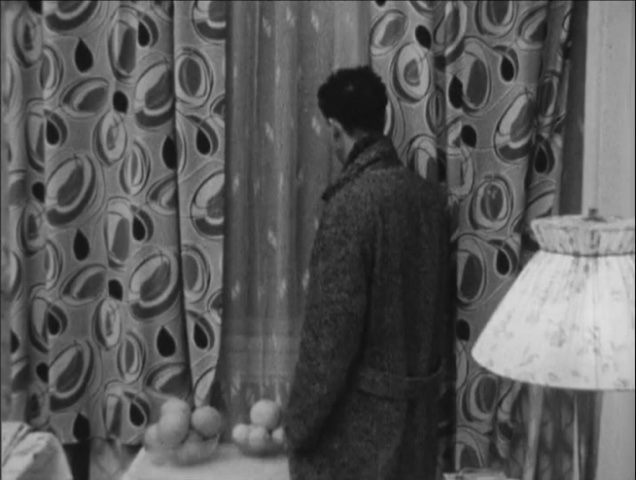
Johannes Beringer, Das Zimmer (1966) – photo taken at the editing table
Even in 1966, during the school’s first year, Swiss student Johannes Beringer together with Skip Norman as camera assistant shot the impressive film Das Zimmer (The Room) about his sublet neighbor, a Lebanese immigrant, who discusses a magazine article about Gamal Abdel Nasser with a colleague. In just a few precise scenes, Beringer suggests his protagonist’s unsuccessful attempts to move into another apartment and his “present absence in the diffuse entity of the city.”13 “First impressions of Berlin because I was a foreigner,” Beringer comments. On two occasions, a figure runs quickly through the frame: Holger Meins, a fellow student of Beringer’s in the first DFFB class.
Exile and Struggles
According to statistics provided by Hans Helmut Prinzler (the DFFB’s director of studies from 1969 to 1979), in the DFFB’s first ten years, 54 out 258 students were foreigners, 13 of whom came from Switzerland alone14, where there was no institutional film education until the mid-1990s. In the first years, a noticeable number of students came from Greece, a result of the military dictatorship there that had begun in 1967. The situation in the students’ countries of origin was often highly problematic.
For his DFFB entrance application, Sofoklis Adamidis (enrolled 1973) wrote a fictional letter from a worker to his parents based on research15 and his own experiences. The letter writer was not only driven away by unemployment and fear of its disastrous consequences in Greece, but also and primarily by political terror and fear of mental deterioration to which he was condemned at home. He wants to taste the most important rights a person is due. And he further laments the fact that the hope that has driven him to Germany has once again been deceived: in the Federal Republic, discrimination already begins with work and residence permits, which are so closely tied and regulated that one can be expelled at any time even without having committed an offence. It is hardly possible to talk about freedom of movement and, furthermore, advocating for democracy in Greece can be construed as endangering the FRG.
In her application, Mehrangis Montazami (enrolled 1972) writes: “There is no crisis in Persia. Persia IS a crisis. Therefore, every Persian is living in crisis. I am a Persian.” In a report for the entrance application, Montazami describes the Arsenal cinema on Welserstraße with its posters and announcements: “To know which film will be shown, I need to move closer to the posters and display cases. I do not see a series of colorful film stills, but many texts on display, partly underlined in red, as well as handwritten sheets of paper and newspaper clippings. Among other things film programs like ‘Militant Cinema in the Third World’, ‘The Cinema of Utopians and Anarchists’, ‘Broken Cinema’, ‘The Cinema of Loners and its Sublation’ are announced.’”16
Born in 1941 in Otjiwarongo in former Southwest Africa, Kampopo Uazuvara Ewald Katjivena writes in his application letter: “Current occupation: politics!”17 He had first-hand experience of the neocolonialism of German settlers. As a schoolboy, he had already participated in protest marches against the “discriminatory Bantu Education Act against Blacks,” which led to him being expelled from school. In 1964, he began working in Tanzania as a radio announcer and deputy commissioner for the SWAPO liberation movement before going to Cairo and, in 1966, he became head commissioner of SWAPO in Algeria and West Europe. In 1973, he came to the DFFB as a visiting student. In 1977, he filmed Give Us Back Namibia about a SWAPO training center in Zambia. He worked after the independence of the Republic of Namibia in 1990 as the program director of the national television station. He has lived in Norway since 2008 and is a cooperating partner of the Black International Cinema in Berlin. During his studies at the DFFB, he participated in seminars on political TV movies, socialist realism, the use of force monopolies and bureaucracy as well as the course “Filming Under Difficult Circumstances.”
Israeli citizen Edna Politi was raised in Lebanon and worked as an editor for Israeli television before coming to the DFFB. In fall 1973, while shooting her film Für die Palästinenser – Eine Israelin berichtet (For the Palestinians – An Israeli Reports, 1974), she became involved in the Yom Kippur War and sent letters requesting a production extension from the academy: “Despite the war, things aren’t so bad for us. The film is not doing so well, however. After lengthy research and finalizing the script, work on the film has had to be abandoned for now because the situation has caused entire ‘objects’ (people, etc.) to disappear for an undetermined amount of time.”18 The film begins with verses by Mahmoud Darwish. Later on the poet Samih Al-Quasim recites a poem. Politi speaks to the camera as an onscreen announcer, asking children in a Kibbutz about their history lessons and also naming the feudal structures of the Palestinian land owners and the ban on unions.19 The finished film was slightly shortened and broadcast by Radio Bremen, and added to the catalogue of the internationalist distributor ISKRA.20
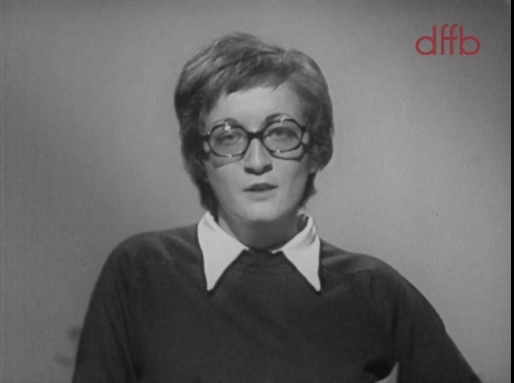
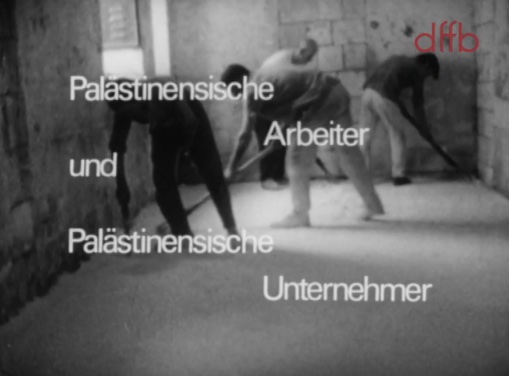
Edna Politi, Für die Palästinenser – Eine Israelin berichtet (1974) – photos taken at the editing table
Anyone coming from a possibly dictatorial nation or a (neo-)colonial society and enrolling at the DFFB brought not only another perspective, but also had a CV marked by multiple experiences with repression and existential resistance, which was, to be sure, significantly different from the other, West German students. This difference also led to the DFFB as an educational institution finding itself confronted by a fundamental critique of its policies and subject matter.
Criticism of Teaching: Gaston Bart-Williams from Sierra Leone
The “liberal internationalism” of the DFFB’s admissions practices occasionally came upon eloquent students who took this practice at face value: Gaston Barton-Williams from Sierra Leone (DFFB student from 1967 to 1970) had worked as a chemist and freelance journalist for the BBC in London and in the Federal Republic as the lead actor in the TV production Der schwarze Doktor (The Black Doctor, Nathan Jariv, 1965, WDR).21 By 1967, his poems had been published in seven different anthologies. He came to the DFFB with a stipend from West German public television (WDR) and with a special recommendation from the television director.
A rejection of established attributions can be read in his application: “I don’t want to study film because I want to become an ‘African’ director.” In filmmaking, he is looking for “a means of expression that is understood internationally, that overcomes geographic, social, academic and political barriers.” In the following maxim, he associates Gorki’s drama about a society in which the intelligentsia misses the pre-revolutionary signs with the works of Jean Cocteau and Else Lasker-Schüler who he admires, sketching a conception of filmmaking as an examination of minority positions: “but since he [Jean Cocteau] did not make a film with the title Kinder der Sonne (Children of the Sun), a portrayal of black-white confrontations in the world, and since he did not draw a portrait of Else Lasker-Schüler, the defender of minorities, I feel myself drawn to supplement the image of the world, the image of our everyday problems and the image of lonely faces in the crowd with a few tesserae.”22
In a letter on March 13, 1969, he requests the “dear directors” of the DFFB once again to reconsider the requirements of the educational contract, and demands that students from the “Third World” not be required to learn material that is groundless and inadequate beyond the geographic limitations and fantasies of particular (local) experts. “I know I can profit myself a lot by cramming European Film History, Film Theories, Publikumswirkung und Theorie der Massenkommunikation und Farbtheorie [audience effect and mass communications theory and color theory], but this only prepares me for a place in the Film industry outside the landscape of the ‘Third World’ and our problems.” He studies film and its possibilities as a political instrument. He wants to learn about the historical role of African Americans in film, the roles of decolonization and new African American consciousness, and the latter also in the context of Latin America (meaning with a perspective on the “Black Atlantic”). He would be happy be questioned about this by Mr. Ulrich Gregor. But: “I am unfortunately basically opposed to the Farbtheorie [color theory] and the dangerous undertones of colour fixations which have miseducated and biased the european [sic] mind as far as colour is concerned and do not feel that I must be forced to undergo the present Farbtheorie course to which I am morally opposed.” With his critique of the course on color theory, Bart-Williams was questioning color norms and their general validity—long before English film scholar Richard Dyer took a look at “whiteness,” and examined and deconstructed the depiction and universal “invisibility” of the category of white (as whiteness and as the skin color) in mainstream cinema.23
He also criticizes the DFFB’s legal economy: “In the case of foreign students who may have to present their work to the responsible authorities in their countries … it would be just for the academy to make concessions with regard [sic] giving students access to copies of their films to take out of the country at the end of their training at the academy.” In the last paragraph of his letter, Bart-Williams politely requests understanding and cooperation. An answer has not been preserved.
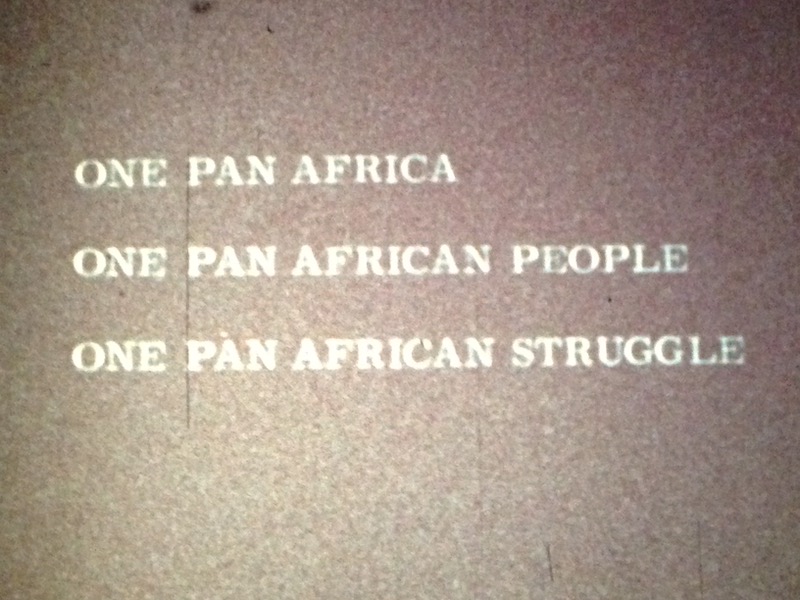
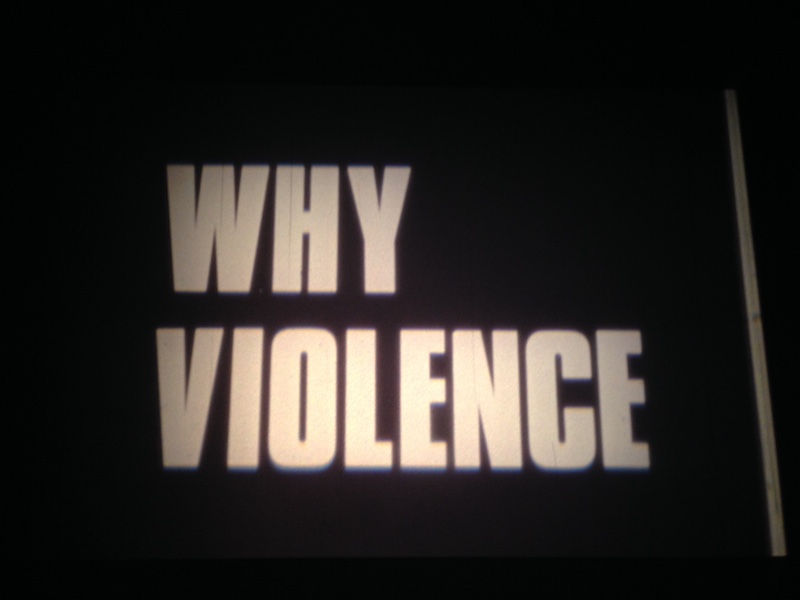
Gaston Bart-Williams, Which Way Africa? Evolution or Revolution (1969/70) – photos taken at the editing table
His thesis film, the militant documentary Which Way Africa? Evolution or Revolution (1969/70), was registered under the title Towards an African Revolution. Shooting in Sierra Leone and the Republic of Guinea, he wanted to show the different aspects of the African revolution in five chapters.24
Demands for Political Consequences: Skip Norman from the U.S.A.
The African-American student Skip Norman studied German language and literature as well as medicine in Göttingen and—like a few of the earliest DFFB students—had also gathered some experience in theater. He studied at the DFFB from September 1966 to late May 1969. In an undated letter to the academy, he appeals to the “dear comrades” and asks: “How can the DFFB contribute to the massive task of raising the welfare of the ‘Third World’? The DFFB can train documentary filmmakers (propagandists) who will not only correct the false picture that has been painted by Western propaganda, but will also strengthen the collaboration between Germany and the ‘Third World’ through reasonable and useful advice regarding development programs. … The practices that the DFFB offers to students from the ‘Third World’ are relevant to the conditions with which they are confronted after their studies. For this reason, the DFFB must take responsibility for educating, liberating, informing, and mobilizing people.” This programmatic passage in the letter, which also speaks a lot about the primacy of the documentary at the time, leads, finally, to the recommendation of a full scholarship for a young man named Moukhtarr Sheriff, who “has proven an interest in film and, likewise, an interest in correcting the warped image of his culture. I trust him to make the best out of his studies.”25 Norman thus takes the “DFFB comrades” at their international word.
Although Norman’s film Blues People (1969) was named after LeRoi Jones and Amiri Barakas’ 1963 study Blues People: Negro Music in White America, it was inspired by Jones/Barakas’ play The Dutchman (1964). In the film he depicts the dynamics of power and the gaze across the gendered Color Line. For almost four minutes, the image remains black, accompanied by prison working songs recorded in 1948 by Alan Lomax at Mississippi State Penitentiary. The first shot following this visually critical preparation: a soft-edged, slit view showing the eyes of a Black man and an off-screen dialogue between man and woman—flirtation turning aggressive. Who is actually staring at who? Naked bodies, sexualized bodies, sex organs, black and white, photos of lynchings committed in Indiana in 1930 with a staring, white audience, murder and metaphors, Bessie Smith. Norman manages a dense, disturbing portrayal of the segregated abysses within sexual relations. With its depiction of naked bodies, the film was so controversial that the film analyst and lecturer Gerd Albrecht wrote a six page “expert opinion” addressing the question of whether or not the film was pornographic. In Norman’s second film at the DFFB, Cultural Nationalism (1971), in a speech referencing Frantz Fanon’s writings critiquing colonialism, Black Panther Party co-founder Bobby Seale develops a rejection of the intellectual and cultural nationalism of a short-sighted and—as he says—corrupt “Black is beautiful” concept that has been absorbed by capitalism. “My second film, based on political material from the BPP, and produced in 1971, was a short impressionistic piece on the BPP’s interpretation of ‘Cultural Nationalism.’ In this film the party differentiates between political awareness and cultural awareness as vehicles for social change. Their point was that cultural awareness without political action was insufficient as a tool for changing the condition of black people in this country.”26
A young Black boy in winter clothing walks out of a quiet, white, snow-covered Berlin landscape towards the camera, takes off his hood and gazes into the lens for a long time, occasionally glancing away, irritated or uncertain. “The Black Panther Party does not hate anyone, and it doesn’t hate anyone because of the color of the skin,” says Bobby Seale off-screen.
Norman became the most productive cameraman in the DFFB’s early years. He was involved in 27 productions and, after his studies, he worked in 1974–75 as a camera teacher and lecturer at the DFFB. Norman also appears on the cover of the fifth issue of the magazine Frauen und Film (1975) and was, as lighting assistant, the only man on Cristina Perincioli’s otherwise all-female crew when she was shooting the strike film Für Frauen, 1. Kapital (For Women, Chapter 1, 1971). In a discussion on the DFFB’s Wochenschau 2 (a self-organized newsreel program that had emerged out of student conflicts), he broached the subject of the student’s unclear legal status: “… we’re talking about parity, but we don’t have a clue what rights we have within this GmbH.”
“Building an Animation Stand”: Carlos Bustamante from Mexico
The history of experimental work at the DFFB still needs to be written. There is a lot of talk in early curriculums about experimentation, which was manifested in different ways musically, aesthetically and technically. In the questionnaire about preparations for the second year that was filled out by third-semester students, “regarding the necessity of ‘experimental exercises,’” 7 students answered with ‘no,’ 14 students with ‘yes,’ and a few students demanded it as a permanent principle.27 Skip Norman obviously wanted to experiment28 and in his films he arrived at results that always consider the (precarious) absence of images as well.
Prior to working on his agitative cinematic poem against the Vietnam War, De oppresso liber (1968), Carlos Bustamante from Mexico (enrolled 1967) was not only familiar with Santiago Alvarez’s legendary agitprop film Now (Cuba, 1965), he had “also seen a lot of experimental cinema and been to live performances: for example, Andy Warhol’s ‘Velvet Undergound’ at the Filmore East in San Francisco used a lot of flicker; a Warhol exhibition in Paris brought ‘screen printing’ to my attention, and also Lichtenstein’s paintings; Gregory Markopoulos’ films had a lot of fade ins and out. Tony Conrad’s film Flicker … The list is long. It was in the air.”29
Co-founder of the Filmemacher Cooperative in Hamburg, Helmut Herbst came to the DFFB in the fall of 1969. Hans Helmut Prinzler, head of the study group, describes the delicate role of the teachers in the heated situation: “The lecturers should—not entirely with authoritarianism—set an example for the near future. Helmut Herbst is in the right place here. He has an attitude towards aesthetic and political questions. He is not an opportunist.”30 In a letter to Herbst sent from Mexico, Bustamante writes: “We are working a lot and, unfortunately, do not have much money. Otherwise we would work a lot more. We have made two films. We have less than a morse tank.31 We wrapped Jornada solidaridad colonias around a wooden frame. Dialogo was developed in a bucket. By chance, I found an old Bell & Howell projector in January for 30 dollars and we are now using it for printing. As soon as I find a few lenses, I will build a rear projection unit. There is so much to do because in Mexico most of the population is repressed. … In Germany, the contradictions are barely visible. In Latin America, it’s all you see. … Capitalism is a cancer. If you don’t believe it, you should come here. … It would be nice to see you again. Warning: you’ll have to work for us to earn your pay. Building an animation stand.”32 Bustamante’s description here of the “technical” experiments is impressive: economically precarious political filmmaking under improvised circumstances.
Ruined Beliefs in New Images: Irena Vrkljan from Yugoslavia
Born in Beograd in 1930, Irena Vrkljan was a writer and TV journalist from Yugoslavia who enrolled in the first year of the DFFB. In a draft for a radio play in the form of a letter, Vrkljan writes: “Being foreign is something you drag around with you. You know, everyone I know here is especially unhappy. Out of fear that I have trouble understanding because it is unarticulated and abstract in a way. The professors are ancient. Not in years. But in the way they talk. In the U-Bahn, I always notice that I come from a small country.”33
Vrkljan produced three unique Berlin films at the DFFB, and furthermore Faroqhi dreht (Faroqhi Shooting, 1966). In this film, she observes Harun Farocki at work on Der Wahlhelfer (The Campaign Volunteer, 1967), a portrait of a campaign volunteer for the Free Democratic Party whose wife and child are waiting for him in Algeria. The frantic filmmaker “idiotically hunts for details” (as Farocki says in the film), to which Vrkljan cuts to joyful music from a Hollywood musical. The inherent fabrication of “documentary truth” is reflected via a shot through Farocki’s glasses of the screen of an editing table as well as through the revelation of his considerations while editing.
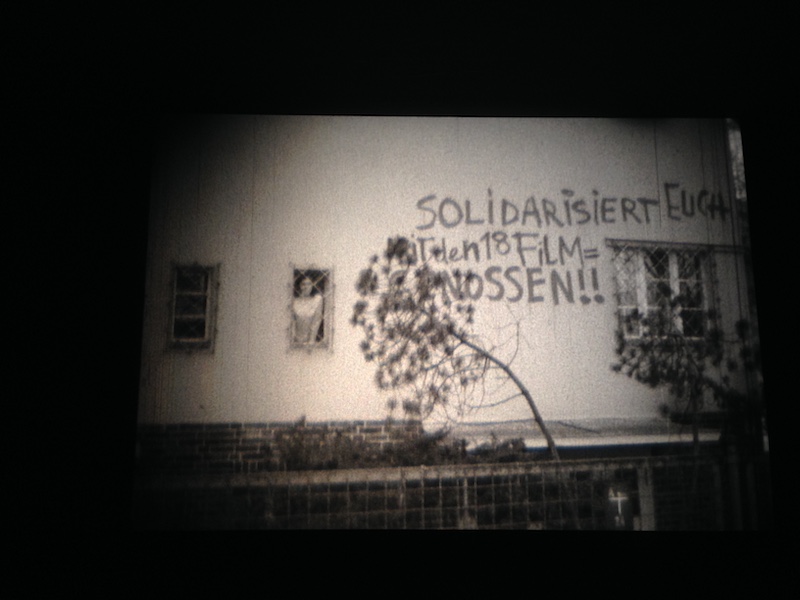
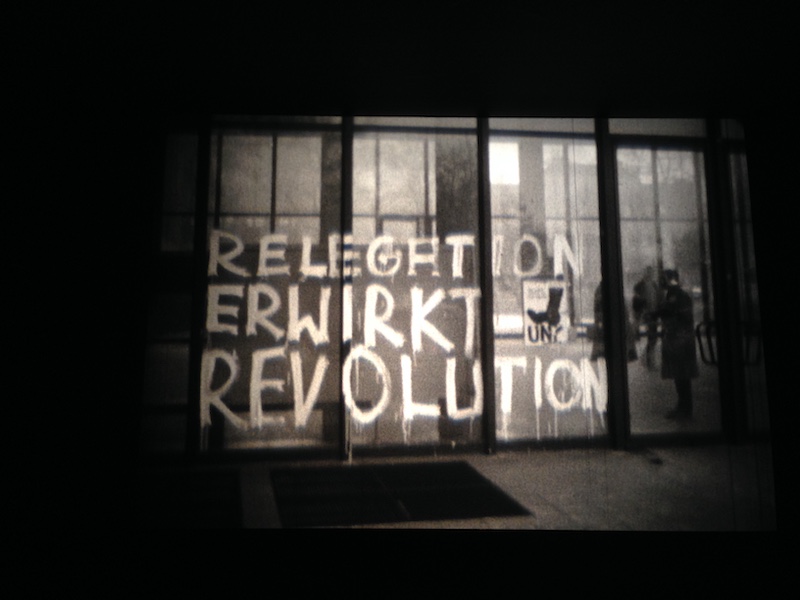
Irena Vrkljan, Berlin (1969) – photos taken at the editing table
As a history-conscious flaneur in Widmung für ein Haus (Dedication for a House, 1966, cinematographer: Michael Ballhaus), Vrkljan investigates the ruins of a neo-Baroque house on Potsdamer Straße und speaks in voice-over about the presence of the past. In Berlin unverkäuflich (Unsellable Berlin, 1967–68), she visits a community garden along the canal in Charlottenburg overlooking the GASAG towers.
These two dense and poetic Berlin films were followed by her 30-minute thesis film Berlin (1969), another city portrait: “Cities are built for you.” She reads inscriptions on houses as demands and a long cemetery sequence ends with footage of ruins being detonated and quotes from the recently published book Die Unfähigkeit zu trauern (The Inability to Mourn) by Margarete and Alexander Mitscherlich. The film shows university buildings in Dahlem, graffiti about DFFB student conflicts—“solidarity with the 18 film comrades!” or “expulsion produces revolution”—and a demonstration filmed in color with many portraits of Mao and Lenin. Peter Schneider’s narration tells the story of a student’s politicization:
We have made mistakes, we are making a full confession. We have been docile, we have been adaptable, we have not been radical. We have applied for enrollment, we have read the enrollment acceptances, we have submitted to the enrollment acceptances. We have filled out forms, which were an impertinence to fill out. We have provided information about our religion although we do not belong to any religion. We have given reasons in our application that were not our reasons. … We have prepared for exams that only served to examine our obedience. We have become nervous. We have become unfunny. We have become more and more difficult. We suffered from deficient concentration. We could not fall asleep. We could not have sex. We spoke out one time. We had to be told that we must first come to terms with ourselves. We came to terms with ourselves. We managed to be able to name at any moment four journals from Goethe’s era. We have provided completely factual information about the Vietnam War although we have experienced that we can cite the most unimaginable details about the American policies in Vietnam without the fantasies of our neighbors gaining any momentum … .
Looking back at the DFFB in her 1988 novel Marina im Gegenlicht (Marina in Backlighting), Vrkljan writes:
One can look at foreign places. Berlin 1966. The film academy on Pommernallee. I was thirty-six. … The film academy was the most foreign place in my life. The neon-lit halls, shiny, cold linoleum, the bossy, spoiled, genderless young people. A madness for film, a hurried life in pictures. And yet we did not create the other reality. We ate dry rolls at film screenings and hung flags at random out of the window. Questions were batted down and many delved deep into politics. The three years of study were like a cold chill down our backs. Heart shriveled and eyes staring at the screen like holes without lids. The course on mainstream cinema in the Third Reich destroyed the last possibilities of believing in new images. Everything got caught on what had already been seen, on the wrong feelings, and political abuses. The power of the images made them questionable in themselves. … Traces of art wiped away. Images are recalled to the criteria of a technology that also constitutes them. I soon had no conversation partner any longer and retreated into books.34
Shift of Focus: Films by Mehrangis Montazami, Sema Poyraz & Sofoklis Adamidis
For a long time, the forms for telling stories of migration on film reproduced the pattern of portraying the plot’s male and, above all, female protagonists as people enduring their fate. In the genre of the dutybound social problem film, female migrants were granted central roles.35 For the world of the Federal Republic and the press, the major entry point consisted in a plunge into victimizing, problem-ridden worlds and it was first necessary for an entire series of films to “work through” the symptoms before new visual strategies of agency became possible.36
Noteworthy here is a film made at the DFFB that has slowly acquired its proper appreciation: in 1980, Sema Poyraz and her Greek fellow student Sofoklis Adamidis shot the film Gölge – Zukunft der Liebe (Gölge – The Future of Love). The lead role of an 18-year-old girl was played by Semra Uysallar. The film was shot in two languages, German and Turkish, with non-professional actors. The parents were played by Birgül and Yüksel Topcugürler who were active in the Friendship League of German and Foreign Workers. A work permit first needed to be obtained for the cameraman, Asil Basyildiz. The film was co-produced by Sender Freies Berlin (Radio Free Berlin), which broadcast it on August 3, 1980 in the series Projektionen.
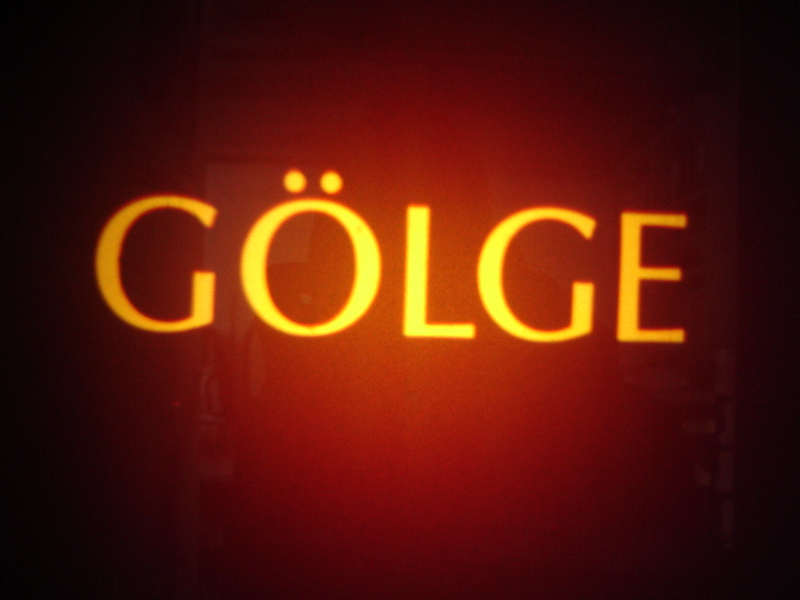
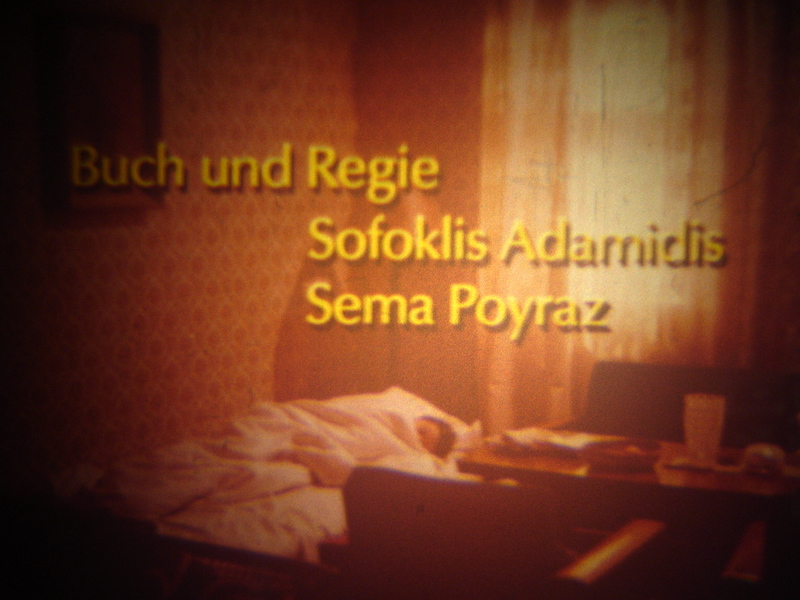
Sema Poyraz and Sofoklis Adamidis, Gölge – Zukunft der Liebe (1980) – photos taken at the editing table
Staged as a chamber play, the film is about the awakening sexuality of the young Gölge and her conflicts with her family. In order to take part in parties thrown by her fellow students, Gölge instigates complicated intrigues at home. Her first flirtations take place under omnipresent social controls. Her parents’ exhaustion, tenderness and tiffs and the conversations between the men and the women are marked by compassionate ambivalence. At the end, Gölge packs her red suitcase and the pull-out sofa in the living room remains empty: she does not need to be saved. A fundamental film of Turkish-German cinema that tread new ground in terms of its conceptual rigor as a portrayal of society as a never-ending negotiation process as well as with its sympathetic staging of the sexual phantasies of Gölge as she grows into an adult.
In a conversation with film scholar Toby Ashraf entitled “Macht bloß keine Filme über Migranten” (“Just Don’t Make Any Films About Migrants”), Poyraz spoke about the situation at the DFFB. Ashraf: “What was it like at the DFFB back then? You were the first Turkish woman who studied there. Was that something special?” Poyraz: “No. That really needs to be emphasized today: it was nothing special. There were people there from Spain, Chile and every possible country. I was a Turkish woman but there was nothing special about that—not for any of my fellow students. Today, a Turkish woman studying film looks rather strange. Back then, it wasn’t at all.” Ashraf: “Does it bother you when people talk to you about it or are you a little bit proud of having been the first Turkish (woman) filmmaker in Germany?” Poyraz: “I’m proud of it, I must say. I don’t know how old Fatih Akin is—he had probably just been born when I started at the film academy.”37
Even before Gölge, Poyraz and Adamidis had shot a film together at the DFFB: Turda – Ein Alltag (Turda – Everyday Life, 1977). The film is a staged documentary and the actress and writer Emine Sevgi Özdamar appears as the mother of the young Turda. The film accompanies Turda, a young Turkish boy whose parents both work, as he plays. He has problems at school—“Turda is a very lively and headstrong student. Frequent mistakes, tardiness to class, an unkempt appearance and disorderly school supplies as well as a lack of support at home are unfortunately keeping him from academic success”—and gets help with his homework at a Turkish afterschool program. In the film’s final image: Turda looks into the camera in a combat position. The impressive documentary footage of migrant Kreuzberg in the late 1970s suffers somewhat from Jo Liebau’s synthesizer score.
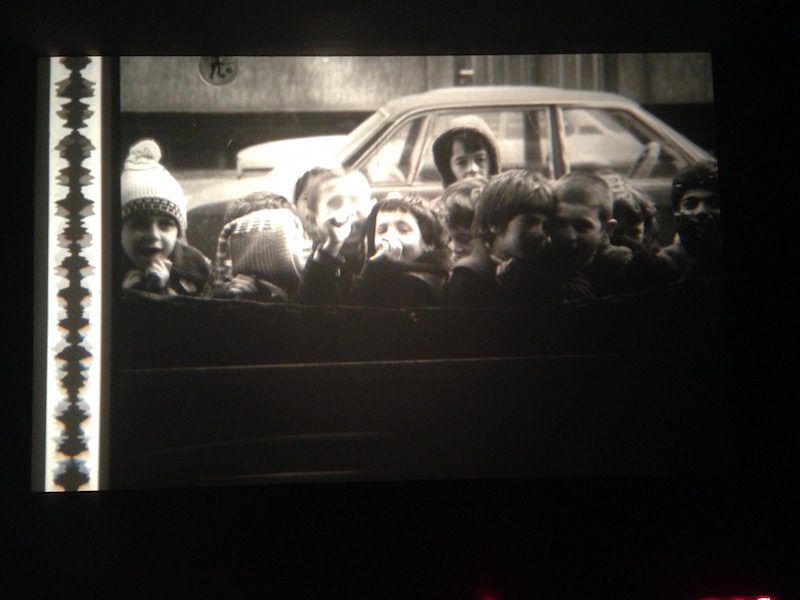
Sema Poyraz and Sofoklis Adamidis, Turda – Ein Alltag (1977) – photo taken at the editing table
In her “in-depth and engaged reportage”38 Analphabeten in zwei Sprachen (Illiterate in Two Languages, 1975),39 Mehrangis Montazami also dealt with the situation in school for foreign children and teenagers in West Berlin. In a DFFB information sheet about the film, she writes: “West Berlin has ‘its’ foreigner problem too. Some districts have already banned foreigners from moving in. (West Berlin is the only city that has done something like that). These are primarily workers who do simple, unskilled labor—i.e. dirty work. Without them, West Berlin society would fall apart.”40
The 1980s: Raoul Peck
Raoul Peck having grown up in Haiti and Zaire came to the DFFB in 1982. His first film, Leugt (Lying, 1983), is a photo-film about lies and the politics of lies and emerged from the impression left by Ronald Reagan’s June 1982 visit to the Federal Republic. It was followed by a short essay film developed during a seminar with Agnès Varda that impressively seizes upon the obdurate mood in West Berlin during the chancellery of Helmut Kohl: Merry Christmas Germany (1984). Using intertitles and found footage, including images of bombed out, post-war Berlin, videos of parliamentary speeches, statements in support of the state during the peace movement, demonstrations, an oblique view of an escalator, and footage of the hazy West Berlin skyline, Peck creates an oddly latent portrait of a dazed-looking society in the frenzy of Christmas shopping. After his studies, Peck planned a film about Kemal Altun, who had killed himself in Berlin because of the threat of being handed over to the Turkish military dictatorship. On the occasion of the premieres of his films I Am Not Your Negro (2017) and Der Junge Karl Marx (The Young Karl Marx, 2017), he said: “If I had stayed in Germany, I wouldn’t have become the same filmmaker. I felt—and this was one of the reasons why I left—that there was a glass ceiling for me in Germany.”41
Reunified Berlin: Films by Wanjiru Kinyanjui, Tsitsi Dangarembga, Auma Obama, Branwen Okpako & Irina Hoppe
The pogrom-like riots in the cities of Hoyerswerda (1991) and Rostock-Lichtenhagen (1992), the attacks in Mölln (1992) and Solingen (1993), and restrictions to the right of asylum in 1993 following Germany’s reunification produced a social climate for which filmmakers attempted to find a language.42
Writer and journalist Wanjiru Kinyanjui came to the DFFB from Kenya in 1987. In her medium length film Black in the Western World (1992), she deals with how it felt to be Black in Germany. A Namibian man recounts being attacked on the S-Bahn. The film’s titles lay scattered across a map of Berlin in an amorphous speech bubble. Kinyanjui views racist footage from everyday German culture and leads a discussion with Tsitsi Dangarembga, who came to the DFFB in 1989 and provides a devastating assessment of her experiences around Berlin.
Dangarembga first gained attention through her prize-winning novel Nervous Conditions (1989),43 which is set in colonial Rhodesia in the 1960s and 1970s. Her documentary video Die Schönheitsverschwörung (The Beauty Conspiracy) is an ironic study of an Afro beauty shop on Kantstraße in Berlin. “This man … has his privileges too. And that’s why he sometimes feels guilty. In order to remain a good man and a good businessman, he sells particular salts and oils. They are supposed to make people who are not so beautiful and privileged become at least a little more beautiful and privileged than they are currently are.” In brief interviews, different customers relate their experiences in reunified Berlin while at the same time providing some customer feedback about hair straighteners, hair for braiding and harmful whitening lotions such as the product Esoterica. The social effects of hegemonic concepts of beauty are made clear.
In a conversation with a journalist from Der Freitag in 2015, Dangarembga recalled: “I was a young directing student—one of my most important educational experiences. That kind of engagement is not so easy to find elsewhere in Germany. You ask why you are okay with something or not. I was surprised that there was hardly anyone in Germany at the time who knew anything about African film. And it was unclear for a lot of people what this Black woman was planning to do.” “No one could understand you?” “I had already had experience with film in Zimbabwe. I had worked as a researcher for an NGO. I was impressed by people who were ready to look beyond the nose of their own culture. It was important for me to learn how to guide actors and that one should never forget: these are human beings.” At the end of the interview, she adds: “New characters can overcome old stereotypes.”44
Auma Obama received her doctorate from the University of Bayreuth and was admitted to study at the DFFB in 1990. She worked on Wanjiru Kinyanjui’s thesis film Der Kampf um den heiligen Baum (The Fight Over the Holy Tree, 1994–95). She completed her studies with the short film All That Glitters (1996): “My film deals with an African woman living in the German countryside alongside of her well-off but emotionless German husband.” During the review before her fellow students and professors, she was assailed with questions and criticisms: “All I could assume was that, from a German viewpoint, the film made the African woman into too much of a victim, triggering an unpleasant feeling of complicity in the audience.”45 The sister of Barack Obama, Auma was the subject of Branwen Okpako’s 2011 film portrait, The Education of Auma Obama.
In 1992, Okpako came to the DFFB in an excited reunified Berlin that had lost its status as an island. In 1986, mobilized by encounters with activist poet Audre Lorde, African-German women had written themselves out of media and cultural invisibility and into history with the book Farbe bekennen (Showing Our Colors: Afro-German Women Speak Out), and organized themselves in groups like ADEFRA (Afro-German Women) and ISD (Initiative Black People in Germany). Okpako felt this energy and dynamics and they became an important source of inspiration. Her short film Landing (1995) recounts the paradox of her character becoming invisible, and in her thesis film Dreckfresser (Dirt Eater, 2000), she turned to the “post” experience of never being able to return to a country that has ceased to exist: she portrays former African-GDR-German police officer Sam Ngankouo Meffire, who was supposed to be marketed as a symbolic figure of “cosmopolitanism.” A cleverly mounted film that focuses with great sensitivity on the (treacherous) ways of speaking of those involved.
In 1994, Irina Hoppe shot her extraordinary thesis film, the documentary Deutschländer46 right in her own backyard of Berlin-Kreuzberg. The film was co-produced by ZDF/Kleines Fernsehspiel, with Thomas Arslan as cinematographer. Teenagers who were born in Germany but whose parents came from, among other places, Kurdistan and Lebanon, act out for the camera their games, computer games and wrestling, and the sentences that surround them in this reunified West German society. In their casually observed games, they perform experiences of violence and strategies for mocking the racist world around them. The editing lends the film its unique rhythm. Single, symptomatic sentences are rhythmically repeated, re-arranged and pronounced as intertitles: “The pronunciation of the word Germany … We are foreigners here, we are foreigners there, what should we do?” In the “Blind Nazi” game, one person is blindfolded: “Ausländer (foreigners) have more chances of course, their eyes are free!”
Recounting Transnational Spaces: Wada (2014)
Khaled Mzehr came to the DFFB in 2013. His first-year film, a debut feature film named Wada (2014), deals with the family man Ibrahim, an instrument maker in Berlin, trying to establish contact with his brother who has gone missing in the Syrian Civil War. The film takes place over the course of a day and recounts this man’s complicated process of deciding to travel to Syria and continue the search. He speaks with a Muslim undertaker in Berlin and watches the bathing of a dead body. The choice of non-professional actors who endow the mise en scène with their own experiences in the Syrian exile community and a style of direction that relies on physically eloquent performances with hints, gestures and postures more than dialogue prove to be extremely productive and moving. The locations in Berlin-Neukölln, shot in a documentary style, precisely and soberly convey the transnational infrastructures of exile communities. “The way he walks makes it seem like the wall of noises before him will open up and close behind him. … In Mzher’s film, the surrounding reality was already there before the plot came about—and it will remain after Ibrahim has gone to Syria. It is already no longer his reality, even if he must still temporarily move through it.”47
The exemplary, above-mentioned filmmakers enter implicitly or explicitly into a dialogue with the realities of the DFFB and describe their concrete experiences with German society from the perspective of their film studies. They made and make differences clear and enumerate possible correctives. In this way, they produced and produce a special, transnational space and a transfer of experiences, knowledge and skills that continues to be written in personal stories, mutual inspiration and special visual politics. In the sense of an interwoven history, transnational learning can be understood here as a process, not only in filmmaking, of constantly shifting perspectives.
Translated by Ted Fendt.
Madeleine Bernstorff is part of the Skip Norman research team, a film programmer and writer exploring the cinema of avantgarde groups, migration and resistance movements in research-based, feminist-motivated and mostly collaborative projects. She teaches film history for art students, e.g. documentary theory, experimental film, boundaries of documentary, and the small form. In 2016–17 she worked with a group producing short video spots mobilizing against the rightwing structural racism in the context of the NSU-Complex. www.madeleinebernstorff.de
Footnotes
1 Madeleine Bernstorff, “Die andere Seite der anderen Seite: Filme von Immigrantinnen und Filmemacherinnen der zweiten Generation,” Femme totale e.V./Feminale e.V.: 100 Jahre Frauen und Kino (Bielefeld, 1996), p. 72ff. In 1997, the Ohneland film program took place during the “… es kommt drauf an sie zu verändern” film festival organized by Blickpilotin e.V. and Kino Arsenal, Berlin. 1
2 The 1965 Ausländergesetz (foreigners law) provided the administrators of the foreigners office with ample leeway in decisions about residence permits until it was replaced in 1990 by an updated version that for the first time included the legal claim to naturalization. DFFB students from other countries needed to report to the foreigners office on a regular basis in order to extend their residence permits. Several thesis films were made under the pressure of these time limitations. 2
3 Heinz Rathsack, Vier Filmhochschulen: Strukturen – Aufgaben – Ergebnisse (Bonn, 1964), p. 33. 3
4 The book appeared in two different German translations in 1958 under the title Die Folter (Torture). One from Aufbau Verlag in East Berlin, one from Kurt Desch Verlag in Vienna. The Viennese edition included an introduction by Jean-Paul Sartre and Eugen Kogon. 4
5 Klaus Wildenhahn, “Aufnahmeprüfung 70 und die Zeit danach,” dffb-Info (April 1/1970). 5
6 Wildenhahn taught at the DFFB from 1968 to 1972 and, as initiator of the “Gruppe Wochenschau,” (“Newsreel Group”), played an important role in mediating between the different, conflicting political camps at the school. 6
7 With the “grade school student films” shot by DFFB students together with grade school students in 1969–70, the filmmakers tried to involve their protagonists in filmmaking for the first time. 7
8 The concept of the “third world” was coined by the demographer Alfred Sauvy in Paris in 1952. He intended it to describe the (formerly) colonized, non-aligned and presumably underdeveloped societies of Asia, Africa and Latin America. With the ongoing decolonization since the 1940s, the non-aligned movement and the 1968 protests, the radical left, especially in France, discovered anti-colonialism and tried to shift away from the Eurocentric premises that are admittedly implicit in the concept of the “third world.” 8
9 Johannes Beringer, “Italienreise 1968,” http://newfilmkritik.de/archiv/2009-11/italienreise-1968/ (accessed on August 15, 2021). 9
10 Dr. Heinz Rathsack, “German Film and TV Academy Berlin,” DFFB (Ed.) (Berlin, 1978), p. 63. 10
11 Between 1955 and 1968, recruitment agreements were made with countries including Italy, Spain, Greece and Turkey. The description of “guest worker” refers to a very specific, temporary policy in the Federal Republic that changed in 1973 with the recruitment stop caused by the oil crisis—although not necessarily in favor of greater social acceptance. 11
12 German Film and TV Academy, “Gisela Tuchtenhagen: Was ich von Maria weiß (1972),” information sheet, no. 66 (January 1972). 12
13 Mark Terkessidis, Interkultur (Berlin: Suhrkamp Verlag, 2010), p. 34. With this expression, Terkessidis describes the (voluntary or involuntary) transitory status of many inhabitants of cities where settling down is no longer the norm. 13
14 Among them film and theater director Daniel Schmid. 14
15 Sources of information provided by Sofoklis Adamidis include the Young Socialist’s 1972 Black Book: Guest Workers and documentation by the Stuttgart student’s union about foreigner rights. Source: Deutsche Kinemathek, DFFB Archive, File: N23009_dffb ADAMIDIS, Sofoklis. 15
16 Source: Deutsche Kinemathek, DFFB Archive, File: N16490_dffb MONTAZAMI-DABUI, Mehrangis. 16
17 Source: Deutsche Kinemathek, DFFB Archive, File: N23313_dffb KATJIVENA, Ewald. 17
18 Edna Politi, letter to production director Müller, November 11, 1973. Source: Deutsche Kinemathek, DFFB Archive, production documents FÜR DIE PALÄSTINENSER, File: N24414_N16573_dffb. 18
19 In a letter from a spectator, these are construed as “communism”: “Although the film clearly displays communist tendencies, the facts that are shown and named are accurate.” Source: Deutsche Kinemathek, DFFB Archive, production documents FÜR DIE PALÄSTINENSER, File: N24414_N16573_dffb. 19
20 The internationalist distributor ISKRA/SLON was founded in Paris in the fall of 1968. 20
21 In a mix of staged and unstaged scenes, the protagonist is shown on his way through the city to the university. His teachers greet him kindly but with the arrogant superiority typical of the time, according to which Africa and the rest of the world merely needed to follow the European example in order to overcome their problems. http://www.filme-aus-afrika.de/DE/film-db/a-z/film-details/w/10583/ (accessed on August 15, 2021). 21
22 Source: Deutsche Kinemathek, DFFB Archive, File: N21553 BART-WILLIAMS, Gaston. 22
23 Richard Dyer’s essay “White,” appeared in Screen 29/4 in 1988, a slightly abridged German translation appeared in Frauen und Film, issue 54/55 in 1994, and in the book White (London: Routledge, 1997). 23
25 Source: Deutsche Kinemathek, DFFB Archive, File: N12697_dffb NORMAN, Skip. 25
26 Wilbert Reuben Norman, Jr., An Examination Of Centenary United Methodist Church Using the Photograph As Artifact, PhD Thesis (Ohio State University, 1984), p. 21. 26
27 “21 questionnaires were returned with answers, which is more than two-thirds of the questionnaires handed out. … It can be viewed as generally representative of the opinions of the student body.” Source: Deutsche Kinemathek, DFFB Archive, File: N4476_Seminarunterl_dffb. 27
28 Source: Deutsche Kinemathek, DFFB Archive, File: N12697, letter from Skip Norman to the DFFB on September 9, 1967. 28
29 Email from Carlo Bustamante to the author on June 8, 2015. 29
30 Hans Helmut Prinzler, “Gemeinsame Jahre: Mit Helmut Herbst an der DFFB,” Helmut Herbst: Dem Licht bei der Arbeit zusehen – Fotografien von Freunden und Kollegen 1964-1990 (Berlin, 2004), Exhibition catalogue, p. 7. 30
31 A morse tank is a small developing tank for hand-processing 8mm, 16mm and 35mm film. 31
32 Source: Deutsche Kinemathek, DFFB Archive, File: N21560_dffb BUSTAMANTE, Carlos. 32
33 Source: Deutsche Kinemathek, DFFB Archive, File: N21512_dffb VRKLJAN, Irena. 33
34 Irena Vrkljan, Marina im Gegenlicht (Graz: Literaturverlag Droschl, 1988), p. 4f. Vrkljan is writing about Marina Zwetajewa here with reference to Anna Achmatova, Natalia Goncarova and herself. 34
35 The most well-known are the films by Helma Sanders-Brahms, Shirins Hochzeit (Shirin’s Wedding, Germany, 1975/76) and Tefvik Baser, 40 QM. Deutschland (40 SQM. Germany, Germany, 1985). 35
36 Cf. The film program “Familien Bande,” part of Projekt Migration at the Kölnischer Kunstverein in 2005, organized by Marion von Osten and Madeleine Bernstorff. 36
37 “Macht bloß keine Filmen über Migranten: Ein Interview von Toby Ashraf mit Sema Poyraz,” Migration: Frauen und Film, No. 67 (2016), Nanna Heidenreich (Ed.), http://www.frauenundfilm.de/?site=hefte&rid=67 (accessed on September 14, 2021). 37
38 Mannheimer Morgen/Mannheimer Lokalnachrichten, October 11–12, 1975, coverage of films screening the week of October 6–11, 1975. 38
39 Her cameraman was her partner and fellow student Reza Dabui, who also shot Skip Norman’s film On Africa (1970). 39
40 DFFB-Filminformation Nr. 114, 1975 (in German), English translation unnumbered. 40
41 https://taz.de/Raoul-Peck-ueber-die-Arbeit-an-zwei-Filmen/!5381591/ (accessed on August 15, 2021). 41
42 Cf. Deutschland und das Ich (Hito Steyerl, 1994), Ohneland (Hatice Ayten, 1995), and Duvarlar/Walls (Can Candan, 1990/2000), https://www.bpb.de/mediathek/305232/duvarlar-mauern-walls (accessed on August 15, 2021). 42
43 Published in German as Der Preis der Freiheit (Hamburg: Rowohlt Verlag, 1991) and Aufbrechen (Berlin: Orlanda Verlag, 2019), both versions translated by Ilija Trojanow. In October 2021, Dangarembga received the Peace Prize of the German Book Trade for her trilogy of novels. 43
44 Sabine Kebir, “Harare Reloaded: Ein Porträt der Künsterlin, Regisseurin und Autorin Tsitsi Dangarembga,” Der Freitag, 20/2015. 44
45 Auma Obama, Das Leben kommt immer dazwischen: Stationen einer Reise (Köln: Lübbe Verlag, 2010), p. 236f. 45
46 A term used in Turkey to describe second and third generation Turkish migrants living in Germany. 46
47 Fabian Tietke, “Die Oberfläche der Narration,” Der Freitag, May 11, 2015, https://www.freitag.de/autoren/der-freitag/oberhausen (accessed on August 15, 2021). 47
[Suggested citation: Madeleine Bernstorff, “Transnational Learning,” Rosa Mercedes 03/C (December 2021), www.harun-farocki-institut.org/en/2021/12/13/transnational-learning/]
December 13th, 2021 — Rosa Mercedes / 03 / C